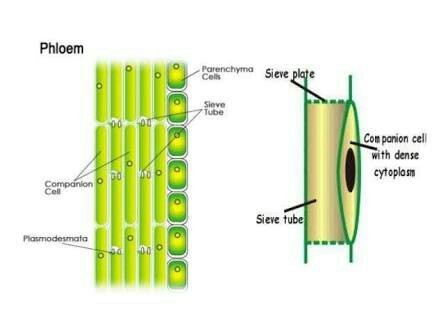Phloem tissue is responsible for the conduction of food materials from the leaves to the rest of the plant body. It is composed of four types of cells – sieve tubes, companion cells, phloem fibres and phloem parenchyma.

Sieve tubes
- It is composed of long narrow tubes called sieve tube elements, arranged in a longitudinal series.
- The cells are vacuolated and the cell wall is made of cellulose.
- These are living cells, but nucleus is absent at maturity.
- The cross walls consists of a number of perforations (pores), and are hence called sieve plates. The pores are called sieve pores.
- The sieve tubes are characteristically found in angiosperms.
- In gymnosperms, instead of sieve tubes, sieve tube cells are present which are not arranged in a series.
Companion cells
- These are specialized parenchyma cells associated with sieve tube elements.
- They are living cells, and have a prominent nucleus.
- It controls the activities of the sieve tube.
- Companion cells are found in angiosperms, but absent in gymnosperms and pteridophytes.

Phloem Parenchyma
- They are thin walled living cells having various shapes.
- The cells are usually elongated, with tapering ends.
- These cells are mainly meant for storage of starch or oil.
- They may, sometimes, also contain tannin, crystals, mucilage, latex etc.
- Companion cells are absent in monocots.

Phloem fibres
- These are elongated sclerenchyma cells found in association with phloem tissue.
- They are also known as bast fibres.
- These fibres have lignified cell walls with simple pits. Phloem fibres are present in angiosperms, but they are rarely found in gymnosperms.
Sieve cells
In gymnosperms and pteridophytes, the sieve tube elements have sieve plates on their lateral wall. These tube elements are not arranged in series, and the companion cells are absent. Such sieve elements are called sieve cells.
Functions of Phloem
- Conduction of prepared food materials (carbohydrates and proteins) from leaves to various plant body parts.
- Provide mechanical support to the plant (Fibres and Stone cells).
- Act as centre of storage (parenchyma).
- In gymnosperm leaves, certain elongated cells having bordered pits are also found in association with xylem cells. This group of cells is involved in lateral conduction, and is called transfusion tissue.
